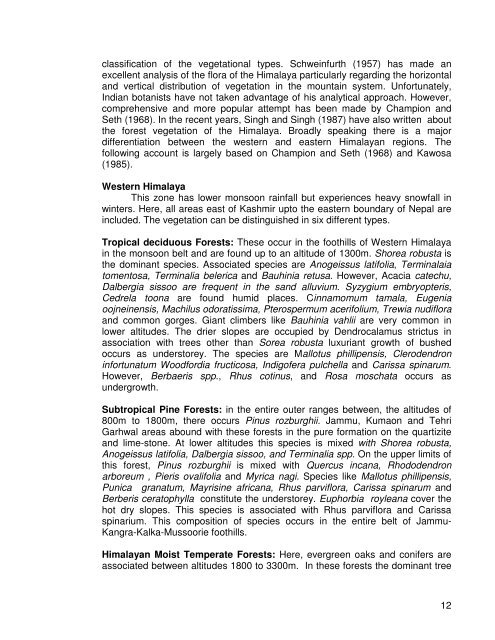Pandit Govind Ballabh Pant Memorial Lecture: II
Pandit Govind Ballabh Pant Memorial Lecture: II
Pandit Govind Ballabh Pant Memorial Lecture: II
Create successful ePaper yourself
Turn your PDF publications into a flip-book with our unique Google optimized e-Paper software.
classification of the vegetational types. Schweinfurth (1957) has made an<br />
excellent analysis of the flora of the Himalaya particularly regarding the horizontal<br />
and vertical distribution of vegetation in the mountain system. Unfortunately,<br />
Indian botanists have not taken advantage of his analytical approach. However,<br />
comprehensive and more popular attempt has been made by Champion and<br />
Seth (1968). In the recent years, Singh and Singh (1987) have also written about<br />
the forest vegetation of the Himalaya. Broadly speaking there is a major<br />
differentiation between the western and eastern Himalayan regions. The<br />
following account is largely based on Champion and Seth (1968) and Kawosa<br />
(1985).<br />
Western Himalaya<br />
This zone has lower monsoon rainfall but experiences heavy snowfall in<br />
winters. Here, all areas east of Kashmir upto the eastern boundary of Nepal are<br />
included. The vegetation can be distinguished in six different types.<br />
Tropical deciduous Forests: These occur in the foothills of Western Himalaya<br />
in the monsoon belt and are found up to an altitude of 1300m. Shorea robusta is<br />
the dominant species. Associated species are Anogeissus latifolia, Terminalaia<br />
tomentosa, Terminalia belerica and Bauhinia retusa. However, Acacia catechu,<br />
Dalbergia sissoo are frequent in the sand alluvium. Syzygium embryopteris,<br />
Cedrela toona are found humid places. Cinnamomum tamala, Eugenia<br />
oojneinensis, Machilus odoratissima, Pterospermum acerifolium, Trewia nudiflora<br />
and common gorges. Giant climbers like Bauhinia vahlii are very common in<br />
lower altitudes. The drier slopes are occupied by Dendrocalamus strictus in<br />
association with trees other than Sorea robusta luxuriant growth of bushed<br />
occurs as understorey. The species are Mallotus phillipensis, Clerodendron<br />
infortunatum Woodfordia fructicosa, Indigofera pulchella and Carissa spinarum.<br />
However, Berbaeris spp., Rhus cotinus, and Rosa moschata occurs as<br />
undergrowth.<br />
Subtropical Pine Forests: in the entire outer ranges between, the altitudes of<br />
800m to 1800m, there occurs Pinus rozburghii. Jammu, Kumaon and Tehri<br />
Garhwal areas abound with these forests in the pure formation on the quartizite<br />
and lime-stone. At lower altitudes this species is mixed with Shorea robusta,<br />
Anogeissus latifolia, Dalbergia sissoo, and Terminalia spp. On the upper limits of<br />
this forest, Pinus rozburghii is mixed with Quercus incana, Rhododendron<br />
arboreum , Pieris ovalifolia and Myrica nagi. Species like Mallotus phillipensis,<br />
Punica granatum, Mayrisine africana, Rhus parviflora, Carissa spinarum and<br />
Berberis ceratophylla constitute the understorey. Euphorbia royleana cover the<br />
hot dry slopes. This species is associated with Rhus parviflora and Carissa<br />
spinarium. This composition of species occurs in the entire belt of Jammu-<br />
Kangra-Kalka-Mussoorie foothills.<br />
Himalayan Moist Temperate Forests: Here, evergreen oaks and conifers are<br />
associated between altitudes 1800 to 3300m. In these forests the dominant tree<br />
12











